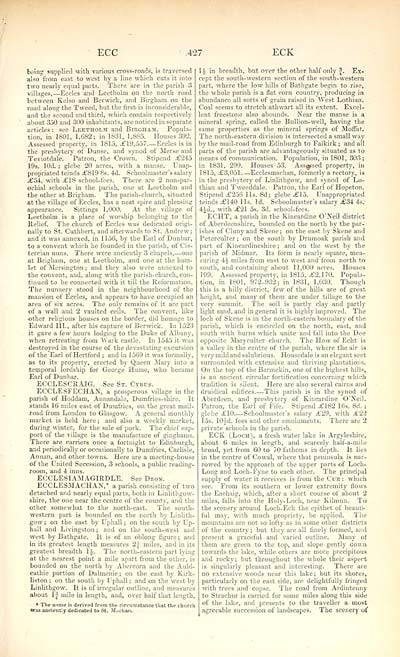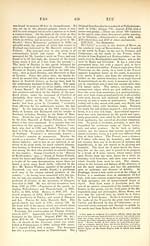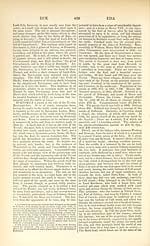Topographical, statistical, and historical gazetteer of Scotland > Volume 1
(513) Page 427
Download files
Complete book:
Individual page:
Thumbnail gallery: Grid view | List view

ECC
.427
ECK
being supplied with various cross-roads, is traversed
also from east to west by a line which cuts it into
two nearly equal parts. There are in the parish 3
villages,— Eccles and Leetholm on the north road
between Kelso and Berwick, and Birgham on the
road along the Tweed, but the first is inconsiderable,
and the second and third, which contain respectively
about 350 and 300 inhabitants, are noticed in separate
articles : see Leetholm and Birgham. Popula-
tion, in 1801, 1,682; in 1831, 1,885. Houses 392.
Assessed property, in 1815, .£19,557 Eccles is in
the presbytery of Dunse, and synod of Merse and
Teviotdale. Patron, the Crown. Stipend £245
19s. lOd. ; glebe 20 acres, with a manse. Unap-
propriated teinds £819 8s. 4d. Schoolmaster's salary
£34, with £18 school-fees. There are 2 non-par-
ochial schools in the parish, one at Leetholm and
the other at Brigham. The parish-church, situated
at the village of Eccles, has a neat spire and pleasing
appearance. Sittings 1,000. At the village of
Leetholm is a place of worship belonging to the
Relief. The church of Eccles was dedicated origi-
nally to St. Cuthbert, and afterwards to St. Andrew;
and it was annexed, in 1156, by the Earl of Dunbar,
to a convent which he founded in the parish, of Cis-
tercian nuns. There were anciently 3 chapels, — one
at Brigham, one at Leetholm, and one at the ham-
let of Mersington ; and they also were annexed to
the convent, and, along with the parish-church, con-
tinued to be connected with it till the Reformation.
The nunnery stood in the neighbourhood of the
mansion of Eccles, and appears to have occupied an
area of six acres. The only remains of it are part
of a wall and 2 vaulted cells. The convent, like
other religious houses on the border, did homage to
Edward III., after his capture of Berwick. In 1523
it gave a few hours lodging to the Duke of Albany,
when retreating from Wark castle. In 1545 it was
destroyed in the course of the devastating excursion
of the Earl of Hertford ; and in 1 569 it was formally,
as to its property, erected by Queen Mary into a
temporal lordship for George Hume, who became
Earl of Dunbar.
ECCLESCRAIG. See St. Cybus.
ECCLESFECHAN, a prosperous village in the
parish of Hoddam, Annandale, Dumfries-shire. It
stands 16 miles east of Dumfries, on the great mail-
road from London to Glasgow. A general monthly
market is held here ; and also a weekly market,
during winter, for the sale of pork. The chief sup-
port of the village is the manufacture of ginghams.
There are carriers once a fortnight to Edinburgh,
and periodically or occasionally to Dumfries, Carlisle,
Annan, and other towns. Here are a meeting-house
of the United Secession, 3 schools, a public reading-
room, and 4 inns.
ECCLESIAMAGIRDLE. See Dron.
ECCLESMACHAN,* a parish consisting of two
detached and nearly equal parts, both in Linlithgow-
shire, the one near the centre of the county, and the
other somewhat to the north-east. The south-
western part is bounded on the north by Linlith-
gow; on the east by Uphall ; on the south by Up-
hall and Livingston ; and on the south-west and
west by Bathgate. It is of an oblong figure ; and
in its greatest length measures 2| miles, and in its
greatest breadth H. The north-eastern part lying
at the nearest point a mile apart from the other, is
bounded on the north by Abercorn and the Auld-
cathie portion of Dalmenie ; on the east by Kirk-
liston ; on the south by Uphall ; and on the west by
Linlithgow. It is of irregular outline, and measures
about 1 J mile in length, and, over half that length,
* The Dime is derived from the circumstance that the church
was anciently dedicated to St. M;ichan.
li in breadth, but over the other half only 3. Ex-
cept the south-western section of the south-western
part, where the low hills of Bathgate begin to rise,
the whole parish is a flat corn country, producing in
abundance all sorts of grain raised in West Lothian.
Coal seems to stretch athwart all its extent. Excel-
lent freestone also abounds. Near the manse is a
mineral spring, called- the Bullion- well, having the
same properties as the mineral springs of Moffat.
The north-eastern division is intersected a small way
by the mail-road from Edinburgh to Falkirk ; and all
parts of the parish are advantageously situated as to
means of communication. Population, in 1801, 303 ;
in 1831. 299. Houses 53. Ass^sed property, in
1815, £3,051 Ecclesmachan, formerly a rectory, is
in the presbytery of Linlithgow, and synod of Lo-
thian and Tweeddale. Patron, the Earl of Hopeton.
Stipend £256 lis. 8d; glebe £15. Unappropriated
teinds £140 lis. Id. Schoolmaster's salary £34 4s.
4id., with £21 5s. 3d. school-fees.
ECHT, a parish in the Kincardine O'Neil district
of Aberdeenshire, bounded on the north by the par-
ishes of Cluny and Skene ; on the east by Skene and
Peterculter ; on the south by Drumoak parish and
part of Kincardineshire; and on the west by the
parish of Midmar. Its form is nearly square, mea-
suring ii, miles from east to west and from north to
south, and containing about 11,000 acres. Houses
199. Assessed property, in 1815, £2.170. Popula-
tion, in 1801, 972-932; in 1831, 1,030. Though
this is a hilly district, few of the hills are of great
height, and many of them are under tillage to the
very summit. The soil is partly clay and partly
light sand, and in general it is highly improved. The
loch of Skene is in the north -eastern boundary of the
parish, which is encircled on the north, east, and
south with burns which unite and fall into the Dee
opposite Maryculter church. The How of Echt is
a valley in the centre of the parish, where the air is
very mild and salubrious. Housedale is an elegant seat
surrounded with extensive and thriving plantations.
On the top of the Barmekin, one of the highest hills,
is an ancient circular fortification concerning which
tradition is silent. Here are also several cairns and
druidical edifices This parish is in the synod of
Aberdeen, and presbytery of Kincardine O'Neil.
Patron, the Earl of Fife. Stipend £182 16s. 8d. ;
glebe £10. — Schoolmaster's salary £29, with £22
15s. lO.Td. fees and other emoluments. There are 2
private schools in the parish.
ECK (Loch), a fresh water lake in Argyleshire,
about 6 miles in length, and scarcely half-a-mile
broad, yet from 60 to 70 fathoms in depth. It lies
in the centre of Cowal, where that peninsula is nar-
rowed by the approach of the upper parts of Loch-
Long and Loch-Fyne to each other. The principal
supply of water it receives is from the Cur: which
see. From its southern or lower extremity flows
the Eachaig, which, after a short course of about 2
miles, falls into the Holy-Loch, near Kilmun. To
the scenery around Loch-Eck the epithet of beauti-
ful may, with much propriety, be applied. The
mountains are not so lofty as in some other districts
of the country; but they are all finely formed, and
present a graceful and varied outline. Many ot
them are green to the top, and slope gently down
towards the lake, while others are more precipitous
and rocky; but throughout the whole their aspect
is singularly pleasant and interesting. There are
no extensive woods near this lake ; but its shores,
particularly on the east side, are delightfully fringed
with trees and copse. The road from Ardinteuny
to Strachur is carried for some miles along this side
of the lake, and presents to the traveller a most
agreeable succession of landscapes. The scenery of
.427
ECK
being supplied with various cross-roads, is traversed
also from east to west by a line which cuts it into
two nearly equal parts. There are in the parish 3
villages,— Eccles and Leetholm on the north road
between Kelso and Berwick, and Birgham on the
road along the Tweed, but the first is inconsiderable,
and the second and third, which contain respectively
about 350 and 300 inhabitants, are noticed in separate
articles : see Leetholm and Birgham. Popula-
tion, in 1801, 1,682; in 1831, 1,885. Houses 392.
Assessed property, in 1815, .£19,557 Eccles is in
the presbytery of Dunse, and synod of Merse and
Teviotdale. Patron, the Crown. Stipend £245
19s. lOd. ; glebe 20 acres, with a manse. Unap-
propriated teinds £819 8s. 4d. Schoolmaster's salary
£34, with £18 school-fees. There are 2 non-par-
ochial schools in the parish, one at Leetholm and
the other at Brigham. The parish-church, situated
at the village of Eccles, has a neat spire and pleasing
appearance. Sittings 1,000. At the village of
Leetholm is a place of worship belonging to the
Relief. The church of Eccles was dedicated origi-
nally to St. Cuthbert, and afterwards to St. Andrew;
and it was annexed, in 1156, by the Earl of Dunbar,
to a convent which he founded in the parish, of Cis-
tercian nuns. There were anciently 3 chapels, — one
at Brigham, one at Leetholm, and one at the ham-
let of Mersington ; and they also were annexed to
the convent, and, along with the parish-church, con-
tinued to be connected with it till the Reformation.
The nunnery stood in the neighbourhood of the
mansion of Eccles, and appears to have occupied an
area of six acres. The only remains of it are part
of a wall and 2 vaulted cells. The convent, like
other religious houses on the border, did homage to
Edward III., after his capture of Berwick. In 1523
it gave a few hours lodging to the Duke of Albany,
when retreating from Wark castle. In 1545 it was
destroyed in the course of the devastating excursion
of the Earl of Hertford ; and in 1 569 it was formally,
as to its property, erected by Queen Mary into a
temporal lordship for George Hume, who became
Earl of Dunbar.
ECCLESCRAIG. See St. Cybus.
ECCLESFECHAN, a prosperous village in the
parish of Hoddam, Annandale, Dumfries-shire. It
stands 16 miles east of Dumfries, on the great mail-
road from London to Glasgow. A general monthly
market is held here ; and also a weekly market,
during winter, for the sale of pork. The chief sup-
port of the village is the manufacture of ginghams.
There are carriers once a fortnight to Edinburgh,
and periodically or occasionally to Dumfries, Carlisle,
Annan, and other towns. Here are a meeting-house
of the United Secession, 3 schools, a public reading-
room, and 4 inns.
ECCLESIAMAGIRDLE. See Dron.
ECCLESMACHAN,* a parish consisting of two
detached and nearly equal parts, both in Linlithgow-
shire, the one near the centre of the county, and the
other somewhat to the north-east. The south-
western part is bounded on the north by Linlith-
gow; on the east by Uphall ; on the south by Up-
hall and Livingston ; and on the south-west and
west by Bathgate. It is of an oblong figure ; and
in its greatest length measures 2| miles, and in its
greatest breadth H. The north-eastern part lying
at the nearest point a mile apart from the other, is
bounded on the north by Abercorn and the Auld-
cathie portion of Dalmenie ; on the east by Kirk-
liston ; on the south by Uphall ; and on the west by
Linlithgow. It is of irregular outline, and measures
about 1 J mile in length, and, over half that length,
* The Dime is derived from the circumstance that the church
was anciently dedicated to St. M;ichan.
li in breadth, but over the other half only 3. Ex-
cept the south-western section of the south-western
part, where the low hills of Bathgate begin to rise,
the whole parish is a flat corn country, producing in
abundance all sorts of grain raised in West Lothian.
Coal seems to stretch athwart all its extent. Excel-
lent freestone also abounds. Near the manse is a
mineral spring, called- the Bullion- well, having the
same properties as the mineral springs of Moffat.
The north-eastern division is intersected a small way
by the mail-road from Edinburgh to Falkirk ; and all
parts of the parish are advantageously situated as to
means of communication. Population, in 1801, 303 ;
in 1831. 299. Houses 53. Ass^sed property, in
1815, £3,051 Ecclesmachan, formerly a rectory, is
in the presbytery of Linlithgow, and synod of Lo-
thian and Tweeddale. Patron, the Earl of Hopeton.
Stipend £256 lis. 8d; glebe £15. Unappropriated
teinds £140 lis. Id. Schoolmaster's salary £34 4s.
4id., with £21 5s. 3d. school-fees.
ECHT, a parish in the Kincardine O'Neil district
of Aberdeenshire, bounded on the north by the par-
ishes of Cluny and Skene ; on the east by Skene and
Peterculter ; on the south by Drumoak parish and
part of Kincardineshire; and on the west by the
parish of Midmar. Its form is nearly square, mea-
suring ii, miles from east to west and from north to
south, and containing about 11,000 acres. Houses
199. Assessed property, in 1815, £2.170. Popula-
tion, in 1801, 972-932; in 1831, 1,030. Though
this is a hilly district, few of the hills are of great
height, and many of them are under tillage to the
very summit. The soil is partly clay and partly
light sand, and in general it is highly improved. The
loch of Skene is in the north -eastern boundary of the
parish, which is encircled on the north, east, and
south with burns which unite and fall into the Dee
opposite Maryculter church. The How of Echt is
a valley in the centre of the parish, where the air is
very mild and salubrious. Housedale is an elegant seat
surrounded with extensive and thriving plantations.
On the top of the Barmekin, one of the highest hills,
is an ancient circular fortification concerning which
tradition is silent. Here are also several cairns and
druidical edifices This parish is in the synod of
Aberdeen, and presbytery of Kincardine O'Neil.
Patron, the Earl of Fife. Stipend £182 16s. 8d. ;
glebe £10. — Schoolmaster's salary £29, with £22
15s. lO.Td. fees and other emoluments. There are 2
private schools in the parish.
ECK (Loch), a fresh water lake in Argyleshire,
about 6 miles in length, and scarcely half-a-mile
broad, yet from 60 to 70 fathoms in depth. It lies
in the centre of Cowal, where that peninsula is nar-
rowed by the approach of the upper parts of Loch-
Long and Loch-Fyne to each other. The principal
supply of water it receives is from the Cur: which
see. From its southern or lower extremity flows
the Eachaig, which, after a short course of about 2
miles, falls into the Holy-Loch, near Kilmun. To
the scenery around Loch-Eck the epithet of beauti-
ful may, with much propriety, be applied. The
mountains are not so lofty as in some other districts
of the country; but they are all finely formed, and
present a graceful and varied outline. Many ot
them are green to the top, and slope gently down
towards the lake, while others are more precipitous
and rocky; but throughout the whole their aspect
is singularly pleasant and interesting. There are
no extensive woods near this lake ; but its shores,
particularly on the east side, are delightfully fringed
with trees and copse. The road from Ardinteuny
to Strachur is carried for some miles along this side
of the lake, and presents to the traveller a most
agreeable succession of landscapes. The scenery of
Set display mode to: Large image | Transcription
Images and transcriptions on this page, including medium image downloads, may be used under the Creative Commons Attribution 4.0 International Licence unless otherwise stated. ![]()
| Gazetteers of Scotland, 1803-1901 > Topographical, statistical, and historical gazetteer of Scotland > Volume 1 > (513) Page 427 |
|---|
| Permanent URL | https://digital.nls.uk/97443702 |
|---|
| Description | Volume first. A-H. |
|---|---|
| Attribution and copyright: |
|

